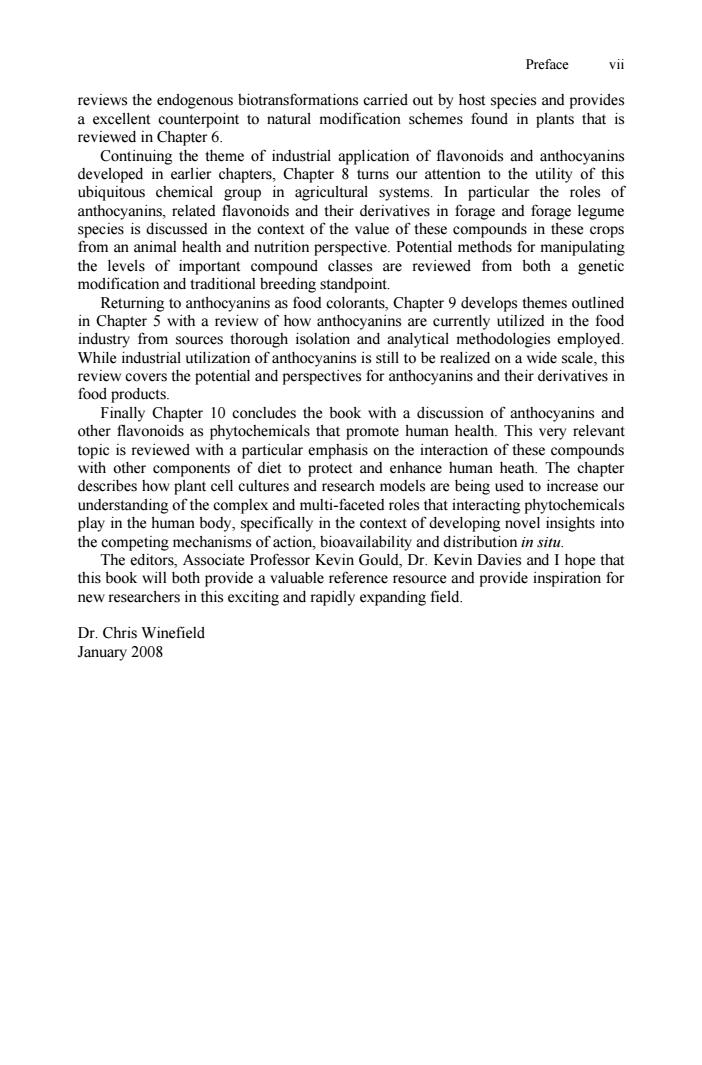正在加载图片...

Preface vii reviews the endogenous biotransformations carried out by host species and provides a excellent counterpoint to natural modification schemes found in plants that is reviewed in Chapter 6. Continuing the theme of industrial application of flavonoids and anthocyanins developed in earlier chapters,Chapter 8 turns our attention to the utility of this ubiquitous chemical group in agricultural systems.In particular the roles of anthocyanins,related flavonoids and their derivatives in forage and forage legume species is discussed in the context of the value of these compounds in these crops from an animal health and nutrition perspective.Potential methods for manipulating the levels of important compound classes are reviewed from both a genetic modification and traditional breeding standpoint. Returning to anthocyanins as food colorants.Chapter 9 develops themes outlined in Chapter 5 with a review of how anthocvanins are currently utilized in the food industry from sources thorough isolation and analytical methodologies employed While industrial utilization of anthocvanins is still to be realized on thi potential and food products. mally Chapter 10 concludes the book with a discussion of anthocyanins and other flavonoids as phyto hemicals that note hur ver is reviewed prom cula a pa emp and uman ell cul chap ease ou d rsta mplex mult aceted roles t t interacting phytoche novel insights into the compe ioavailal tion in s ciat Kevin Gould, andIhope th th provide a valuable re erence resource and provide inspiration for new researchers in this exciting and rapidly expanding field. Dr.Chris Winefield January 2008 Preface vii reviews the endogenous biotransformations carried out by host species and provides a excellent counterpoint to natural modification schemes found in plants that is reviewed in Chapter 6. Continuing the theme of industrial application of flavonoids and anthocyanins developed in earlier chapters, Chapter 8 turns our attention to the utility of this ubiquitous chemical group in agricultural systems. In particular the roles of anthocyanins, related flavonoids and their derivatives in forage and forage legume species is discussed in the context of the value of these compounds in these crops from an animal health and nutrition perspective. Potential methods for manipulating the levels of important compound classes are reviewed from both a genetic modification and traditional breeding standpoint. Returning to anthocyanins as food colorants, Chapter 9 develops themes outlined in Chapter 5 with a review of how anthocyanins are currently utilized in the food industry from sources thorough isolation and analytical methodologies employed. While industrial utilization of anthocyanins is still to be realized on a wide scale, this review covers the potential and perspectives for anthocyanins and their derivatives in food products. Finally Chapter 10 concludes the book with a discussion of anthocyanins and other flavonoids as phytochemicals that promote human health. This very relevant topic is reviewed with a particular emphasis on the interaction of these compounds with other components of diet to protect and enhance human heath. The chapter describes how plant cell cultures and research models are being used to increase our understanding of the complex and multi-faceted roles that interacting phytochemicals play in the human body, specifically in the context of developing novel insights into the competing mechanisms of action, bioavailability and distribution in situ. The editors, Associate Professor Kevin Gould, Dr. Kevin Davies and I hope that this book will both provide a valuable reference resource and provide inspiration for new researchers in this exciting and rapidly expanding field. Dr. Chris Winefield January 2008